COLUMBUS, Ohio — Trying to figure out why the Polaris Slingshot exists is a pointless endeavor. Why did you climb that mountain? Because it was there. Why did you go for two? Because I couldn’t go for three. Why did Polaris build the Slingshot? Because they could. And, more important, because it’s fun.
Before we get any further into what it’s like to drive, let’s talk about what the Slingshot actually is, because it’s not exactly clear just looking at it. For starters, it’s got three wheels, which means it lands somewhere between a traditional car and a motorcycle. The single rear wheel is belt driven, like a motorcycle, but the tandem seating position, steering wheel and pedals mean it’s piloted like a car. Whether or not you need a motorcycle endorsement to drive it depends on your state, but regardless of local laws, Polaris suggests a full-face helmet be worn at all times.
There’s no real trunk space, but there are weather-resistant storage bins behind each seat that are large enough to swallow a helmet, and there's a glovebox. An optional (and rudimentary-looking) roof is available, but our tester didn’t have it, and in any case, weather protection is not the Slingshot’s strong suit. There’s no climate control, though there is an audio system, navigation and cruise control. Put simply, buyers aren’t going to be choosing to park a Slingshot in their garages based on practicality.
Looking past its layout, the Slingshot's styling is equally unlike anything else you'll see on the road. The most common comment we heard is that it's vaguely Batmobile-esque, despite our test vehicle's bright blue hue. It's very angular, which gives it an interesting triangular theme, but all those creases and indentations are darn near impossible to keep clean. Fortunately, the interior is designed to be highly resistant to damage from the weather. We got caught in the rain a few times during our testing period and had no problems other than some water sloshing around the floorboards.
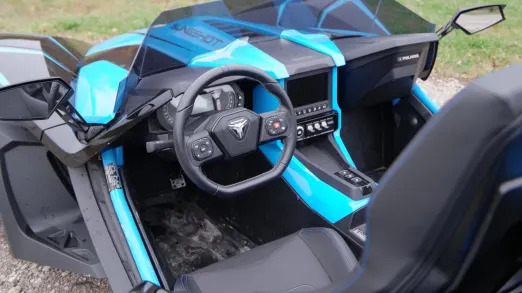
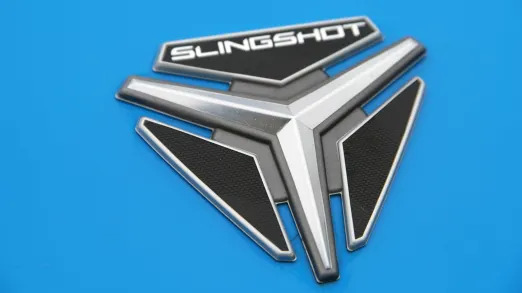
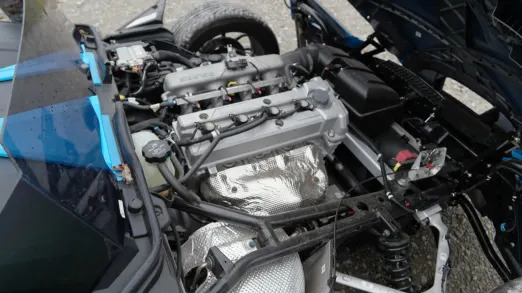
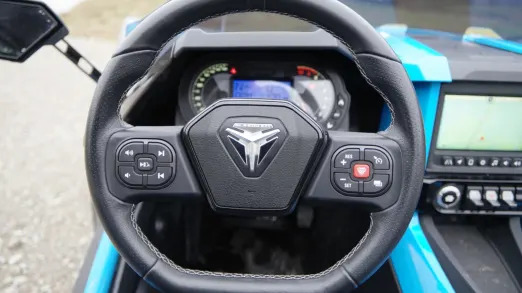
It’s all rather strange and doesn’t fit neatly into any common vehicle segment — Polaris calls it an autocycle, for what it’s worth — but it’s mostly easy to forget the category-defying nature of the thing once you’re moving down the road. A subtle reminder of the Slingshot’s tripod shape is the fact that bumps in the middle of the road will be skipped by the front wheels but impacted by the rear. It’s not really a problem, except for the fact that your backside will feel bumps in the road no matter what you do, but it’s an odd sensation that your brain will have to get used to.
Power for the Slingshot R that we tested comes from a 2.0-liter four-cylinder engine that spins out 203 horsepower at 8,250 rpm and 144 pound-feet of torque at 6,500. A less-powerful version with 178 hp and 120 lb-ft comes in lower-spec Slingshots, but we haven’t tested that one to offer a seat-of-the-pants comparison. The Prostar engine was designed by Polaris, and it replaces the 2.4-liter that was sourced from General Motors and used in Slingshots up until 2019.
Also new for 2020 is an AutoDrive transmission, which is basically a manual gearbox with electronic sensors and servos that shift the gearbox through its five ratios automatically. This transmission comes standard in the base SL model, while the R model can be optioned with either a traditional five-speed manual or the automated version. Apparently and not surprisingly, around 80 percent of Slingshot buyers are opting for the automatic.
Our tester came with the AutoDrive, and, well, we wish it hadn’t. Besides our preference toward manual transmissions in general — particularly with performance-oriented vehicles like the Slingshot — the AutoDrive transmission in our 2020 Slingshot wasn’t very smart. There’s too much hesitation between shifts, and low-speed operation sometimes feels like a herky-jerky dance between clutch on and clutch off.
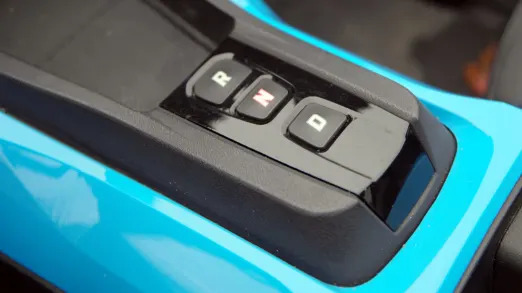
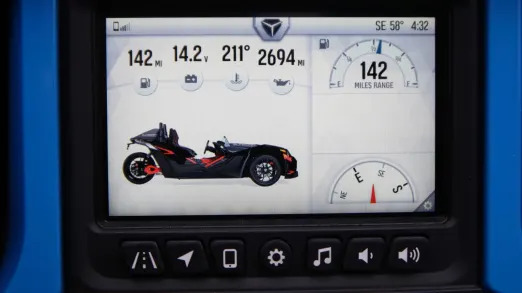
Fortunately, Polaris listened to the feedback of testers and owners and has tried to address some of these issues for the upcoming 2021 model year. In addition to retuned programming that’s supposed to help with the hesitation we experienced, paddle shifters have been added to the steering wheel. Both of these updates should drastically improve the Slingshot AutoDrive experience, and the best news of all is that they will be offered to owners of 2020 models. The programming update is free while the shifters will run $399 plus taxes and installation from any Slingshot dealer.
The Slingshot has two drive modes, Comfort and Slingshot, that can be selected through buttons on the steering wheel or through the centrally mounted seven-inch Ride Command display. Slingshot mode alters programming to hold gears longer and to make the engine more responsive, and it’s immediately obvious which mode the vehicle is in from behind the flat-bottom steering wheel. We preferred the more immediate throttle response in Slingshot mode, but in either mode found the transmission tuning left much to be desired. We strongly suggest that owners of the 2020 model get those paddles installed pronto so they can take over the shifting duties for themselves.
The Slingshot’s variable rate power rack-and-pinion steering is quick (2.5 turns lock to lock) and light — thanks in no small part to the vehicle's 1,653-pound curb weight — and the 225/45R18 front tires and 305/30R20 rear tire provide more cornering grip that we expected. Stability control and traction control are standard, which means the driver will need to turn off the nannies to get any measure of slip or wheelspin. A double press of the appropriate button is required to turn traction control completely off, and once that happens, there’s more than enough power to initiate smoky burnouts.
The new 2.0-liter engine revs all the way to 8,500 rpm and sounds pretty dang good in the process. The sound is somewhere between the revvy buzz of a sportbike and the hornet’s nest of a sport compact. Once up to highway speed, however, the oncoming rush of wind masks pretty much any other sound you might otherwise hear. We racked up around 200 miles on one extended highway trip, and suffice it to say that’s definitely not the best way to experience the Slingshot’s charms.
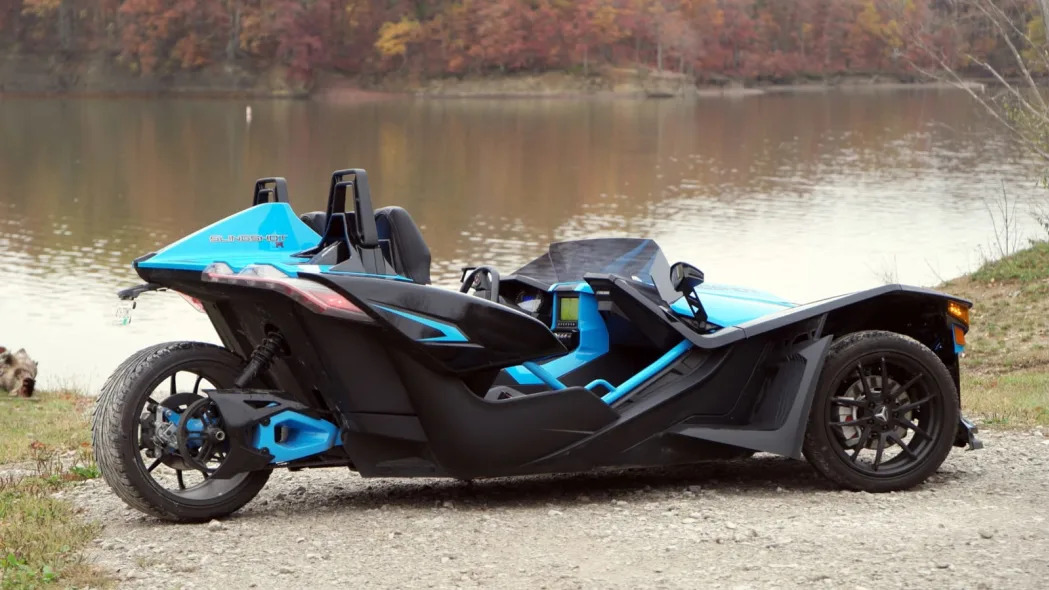
We think most Slingshot owners will be best served on windy two-lane ribbons through pretty scenery on sunny days. Granted, that’s not a large ideal usage scenario, but that’s also how a lot of sports car and sportbike owners use their rides. And while the 2020 Slingshot’s $26,499 starting price, and especially the $30,999 asking price of the R model we tested, strikes us as quite a bit of money for a fancy plaything, we won’t cast judgment on anyone who chooses to park one in their garage. Because above all else, the wind-in-your-hair exhilaration of the Slingshot is nothing if not fun, and its stable three-wheeled design makes it more accessible to a lot of riders than a motorcycle.
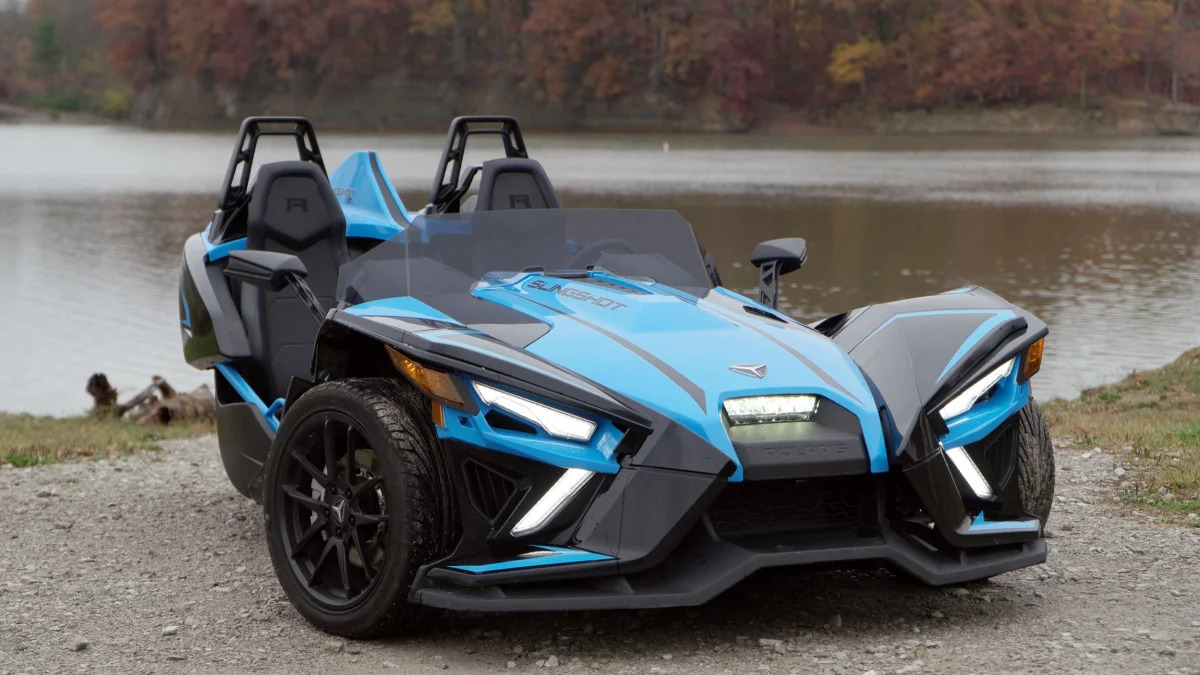









Sign in to post
Please sign in to leave a comment.
Continue